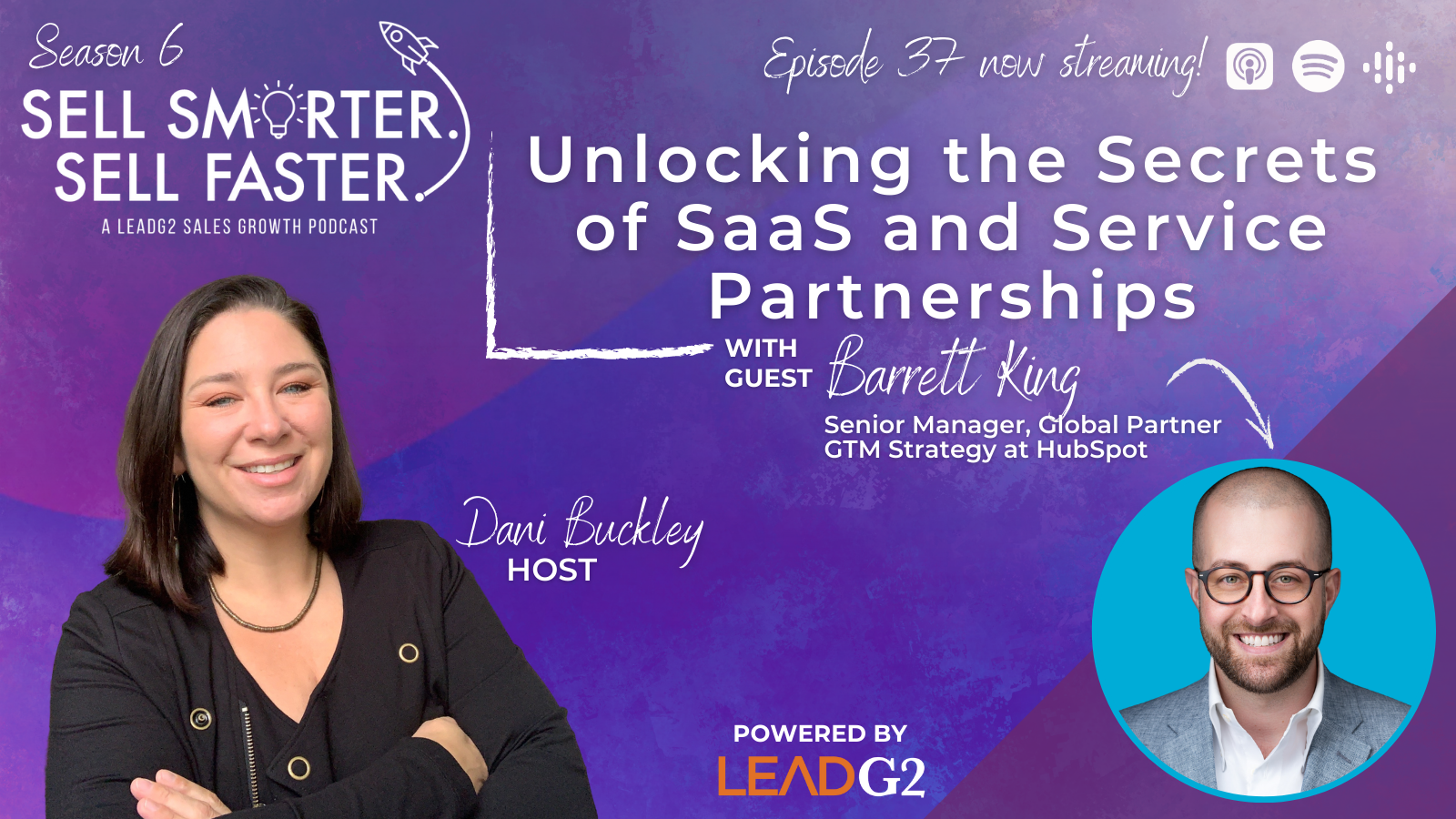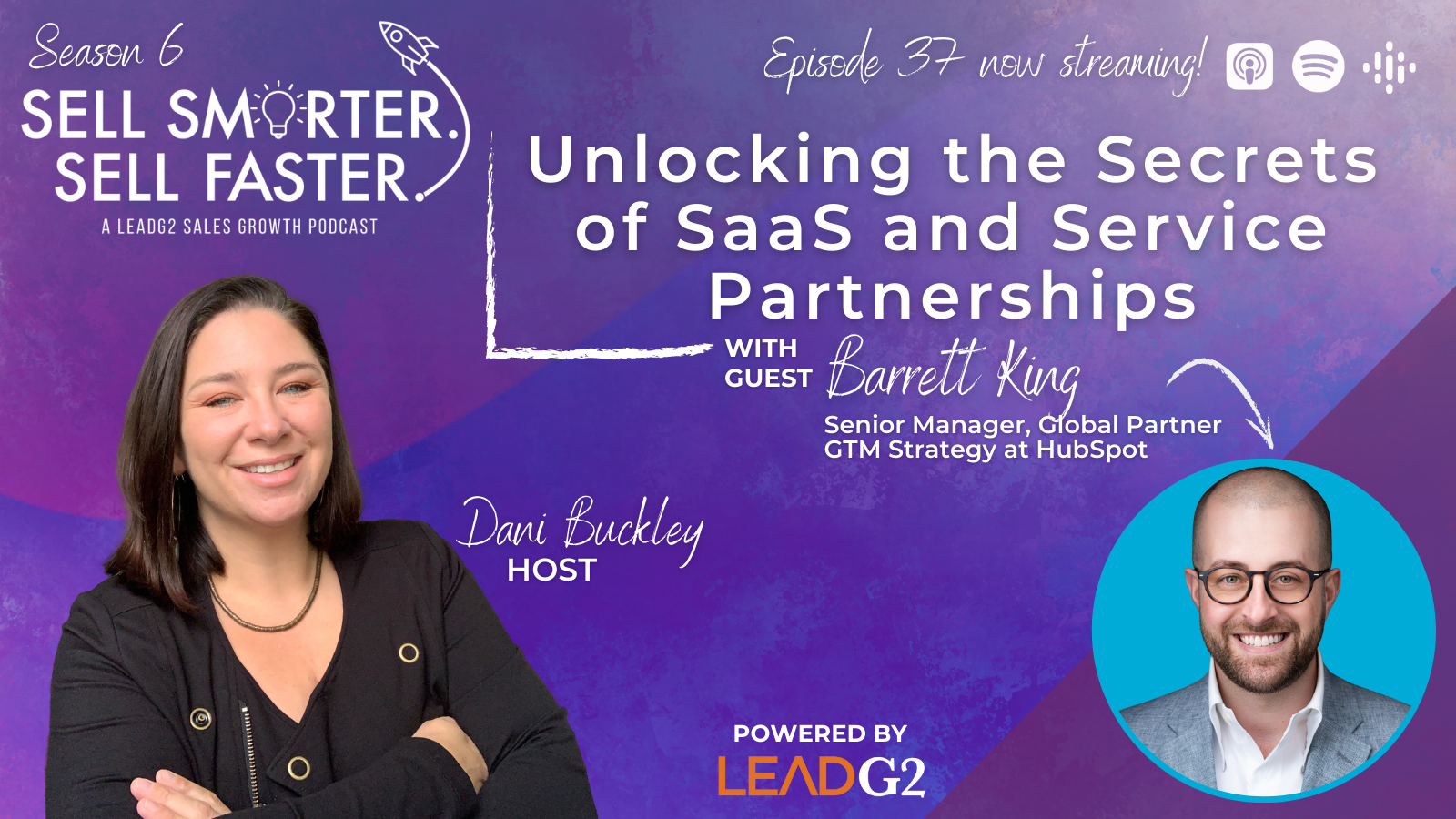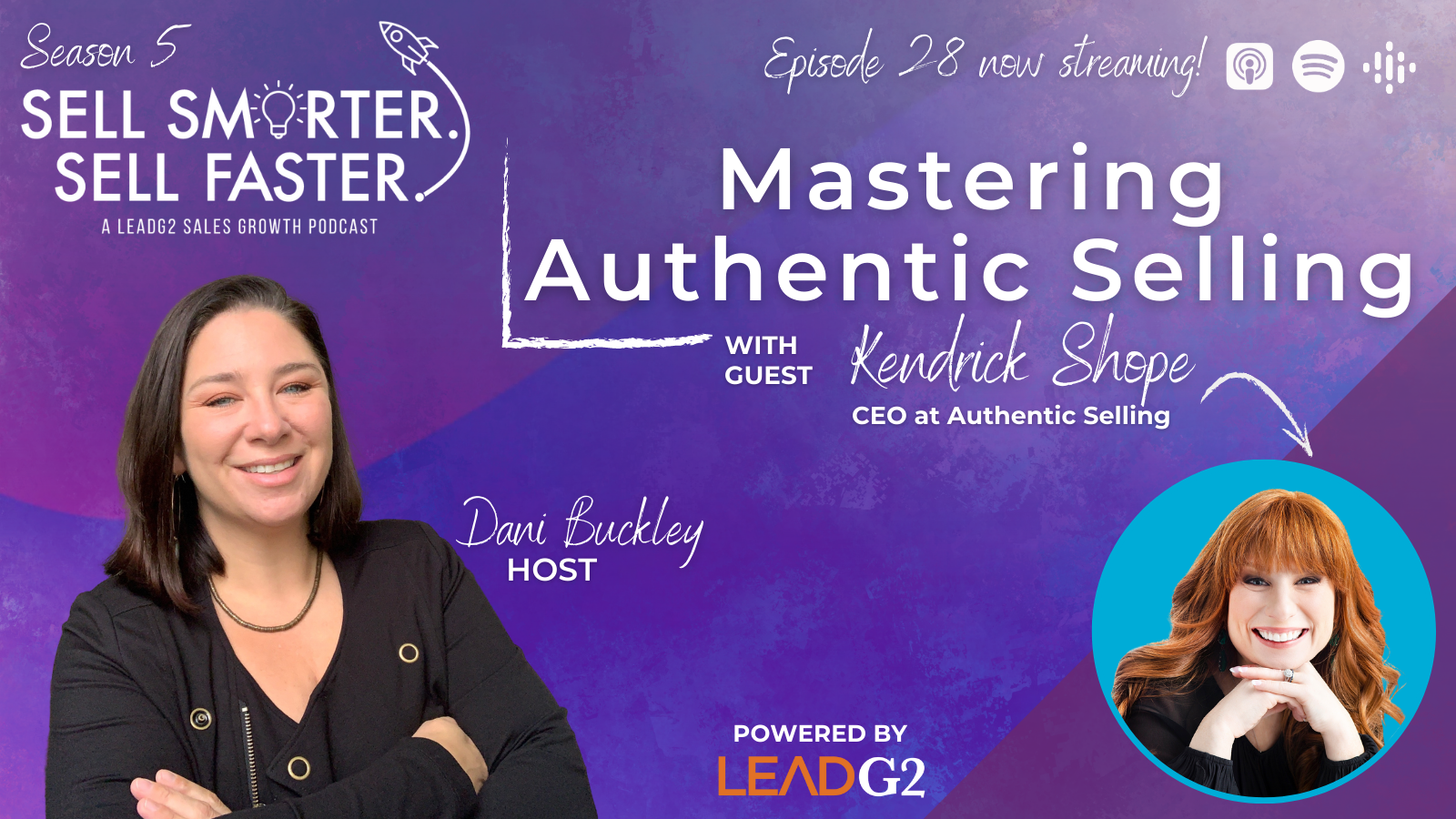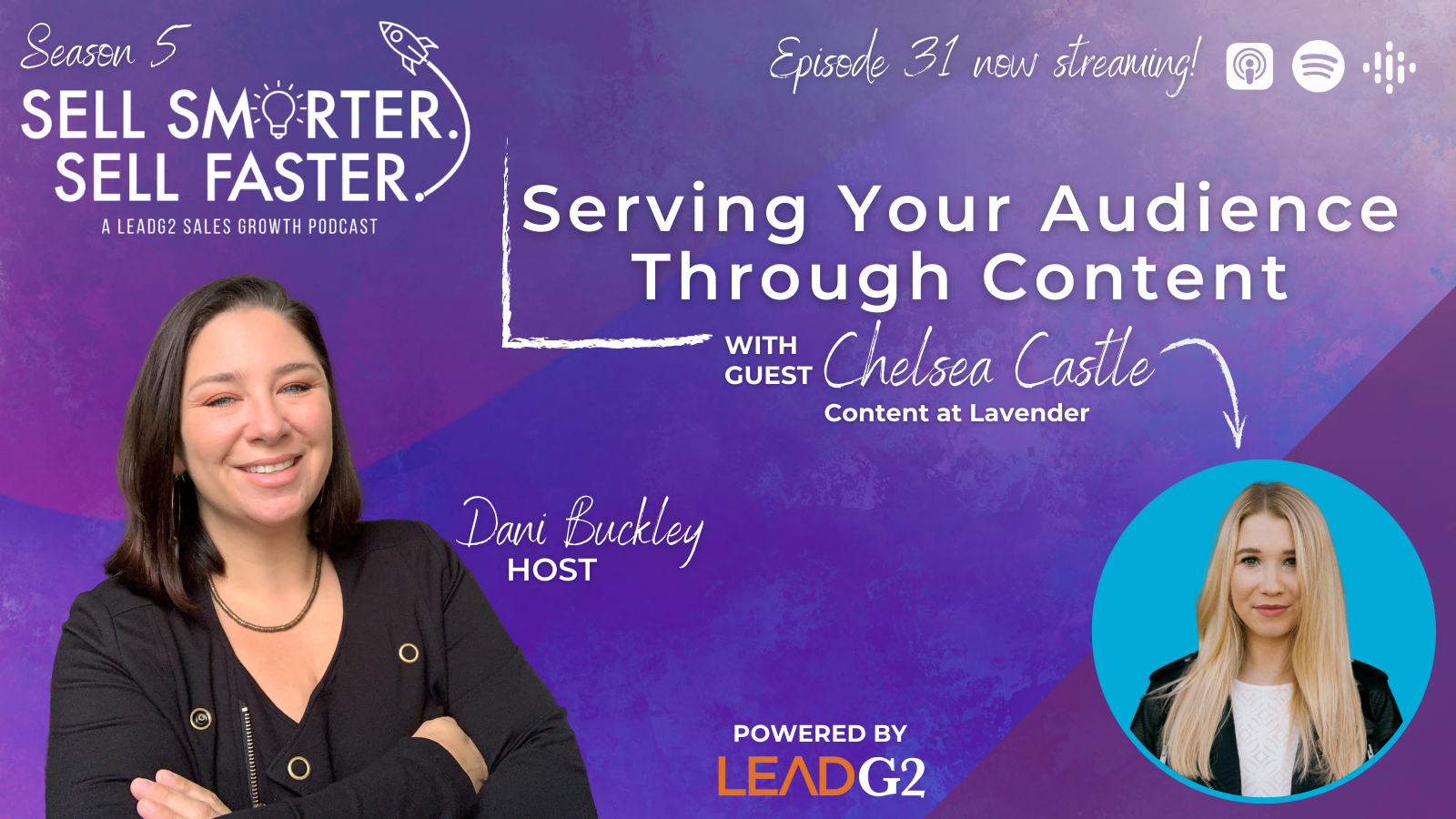Mastering Authentic Selling with Kendrick Shope
In this episode of Sell Smarter, Sell Faster, we’re digging into the world of Authentic Selling. What is it and how can you hone in on this as a...
9 min read
 Brent Tripp
:
July 26, 2023
Brent Tripp
:
July 26, 2023


In this episode, we’re discussing partnerships. Specifically, why fostering and maintaining them are so critical when it comes to growing your business.
We ask questions like: What makes an effective partnership? For those exploring potential partnerships, how do you know you’re making the right decision? And how do you measure the success of a partnership?
Joining host Dani Buckley to answer those questions and more, is Barrett King, Senior Manager, Global Partner, GTM Strategy at HubSpot. Barrett shares a ton of great insights, including:
How, when looking for potential partnerships, you should look to the products and services that are used in tandem by your end customer
Why it's important to aim for a surround sound approach when entering into a partnership.
And, finally, why every partnership should feel like you're investing in a lucrative relationship.

“So, just to make sure we're talking about the same thing,” Dani says. What are we talking about when it comes to partnerships? Give us some context or examples in the B2B world.
Barrett says, “Keeping it really simple, there's a few different components that make up any sort of partnership in that sense. The very heady sort of ‘theory definition’ would be, ‘It's the intersection of value between two or more parties.’ That’s sort of like the dictionary definition, I guess.
“In many ways, I would go bigger than that. I would say it starts with a couple different dynamics.
“One could be something like a vendor partnership. So, you could say, ‘I'm a software company, B2B, SaaS, for ease of example, and I work with X, Y or Z integrations.’ You know you're a software provider and you work with companies to help them build websites. Everyone loves AI right now, so we can say maybe there's an AI platform that plugs into your website system and allows you to really easily populate content. That would be an example of a partnership, specifically a tech partnership.
“You also, in the same sort of example, might be that same vendor. You've got a website platform and you work with businesses that build websites, agencies or consultants and whatnot. You might build a channel program through something like that, a reseller program, where they would use your software to help their customers build websites and subsequently sell that software as well.
“So, again, I think about it as the intersection of the transfer of value between different businesses and, in particular, in B2B, it tends to be additive in some capacity.”
“What makes a partnership effective?” Dani asks. “What makes them good? What makes them work? Any best practices that you can speak to?”
“I think it's actually more simple than most folks make it,” Barrett says. “You know, ultimately, partnerships again being about the transfer of value.
"Actually, it's interesting. I just talked to somebody this morning. He's selling hardware with services to companies. They install electric vehicle chargers in homes.
“So, they procure the actual system, and they install it, and they set up your kind of home chargers network or whatever. That's super niche and interesting and fascinating, and certainly, there's demand for it. And one of the things he was asking me about, specifically, was, ‘how do I go and figure out who I actually should work with from a reseller perspective, from a co-service perspective, all of the individuals that would deliver value to my customer?’
“And I was like, ‘well, it's that statement right there.’
“When I think about defining and really building out best practices and partnerships, you need to figure out what your end customer is likely doing with somebody else.
So, if you think about what you do, we’ll actually use this example, you build chargers for EV cars to install in people's houses. Those individuals are probably working with some form of a car dealer; they're buying their vehicle at some point. They're probably working with some sort of a mechanic or servicing business. They're probably working with an electrician before the installation. They may have other green initiative-based things. Maybe they work with solar companies; maybe they work with other vendors.
“In that regard, those are the likely intersections of value that are happening around your product or service offering.
“So, we could say that we might partner with those folks. And if I back up and I say, ‘Well, how do I think about this more broadly, across any type of partner program or opportunity?’ I would actually anchor in this idea of, ‘What are the services and the products that are being used by your customer, either in tandem, ideally, with your own product or service offering or in a kind of additive motion?’
And if you think about best practices, you should really look for what your customer is they, themselves, looking for that you don't provide. Again a product or service. Look to those organizations as your earliest opportunities to partner.
And it's sort of the opposite of what you hear folks say. Because usually, they'll say things like, ‘How do I work with the companies to help sell more of my product?’ or ‘How do I work with companies to service more?’
It's actually a step beyond that, which is, again, what are the products and services and who are the companies that are talking to my customer already? And who is my customer working with that I have an opportunity to work with as well to increase my reach, my market penetration, and the value I deliver to that customer?”
“Got it,” Dani says. “Makes sense. Love it.”
“Here's what I want to talk about next,” Dani says. “Partnerships should always be mutually beneficial, of course, but sometimes there can be different dynamics that exist.
“I'm going to give the example of us, LeadG2. We are a reseller; we are a partner of HubSpot and other software as well. Hubspot does not resell LeadG2. It is a one-way thing, even though it's a mutually beneficial experience.
“How can the reseller take best advantage of these partnerships in growing their business? Because it's one thing to be like, ‘okay, I know this is a product or a service or a software that makes sense for my business model, that my customers need, but what else can they be doing? What do you see that really takes you from doing well to doing great?
“Yeah, when I think about one of the things that somebody who's engaged in the software company can do really effectively, it starts off with being intentional around taking advantage of the ‘surround sound.’
“So, it's super easy to say, ‘I get value from this single dimension,’ whatever it is. Like, ‘I resell a software, I use a software delivered to my customer’ or whatever that intersection is.
“When you look at the way that people get around that and grow their opportunity, it gets far more interesting.
“You see a lot of vendors say like, ‘Okay, cool, we've got a software company. It says we've got a reseller motion here. We also have an implementation motion. So, you sell the software, and now you can implement it as well.’
“Or it might have a need for integration works. You say, ‘Okay, cool, I'll skew a little more technical. My team's going to get really tuned up. Do good integration works.’ So now I can resell the software on the front end and I can integrate because now maybe I can get some referrals from that company as well. Things like that.
“The third obviously would be you could build something, right? I think it's really easy in B2B and SaaS to say, ‘We've got something going on, it's working really well. You know we can sell it and we can service the customer that way.’ What if you built other things to add value on top of that? That could be another really interesting opportunity for you to say, ‘Alright, we'll do the sales thing in the front and will service our customers better in the middle, maybe get some good referrals. Let's build something together that helps the customer. Give them more value from the ecosystem.”
“I love that,” Dani says. “There's more opportunity than it just being this simple, ‘I sell this thing, and I follow this linear path.’
And you're touching on this in those areas, but I just want to emphasize it because I know it's been my experience and I'm curious if you have anything to add. It's also just building relationships, right? Whether there is the opportunity to get referrals or just to strengthen the relationship and even just to see and explore the opportunities that you just mentioned, that happens through real relationships.”
“It's 3D chess,” Barrett says. “That’s how I always describe it. It's not a single dimension.
“We're not talking about advancing left, right, straight or otherwise. Look at the board game in multi dimensions and it is a game.
“I don't mean to be facetious or kind of tongue-in-cheek, but it's important to think about it in that sense.”
“So, you know, our primary audience here is sales leaders, business leaders of sales organizations,” Dani says. “In the B2B world, for those that are maybe considering or exploring new partnership opportunities, do you have anything that you would advise?”
“What should they be thinking about looking out for to make the right decision?
“You have to listen to the market first,” Barrett says. “It's actually really easy, and I think this is probably more of an American view, so forgive me if you have European listeners. I think the thing that we don't do well here, and I'm an American myself, so I'll say this in open self-deprecation, we are very ‘me-centric as a culture, as a society.
“I talk to hundreds of leaders a year now, at this point, about partnerships. ‘How do I start a program’ is the first question usually, and if it's not that, it's ‘How do I work with companies to make more money or to grow my business faster,’ kind of thing.
“You have to go back to the root of why you're trying to do this, which is to help your customer. So, I had somebody recently say to me, ‘How do I build a partner program?’
“I was like, ‘Well, when was the last time you talked to your customer?’
They were like, ‘Sure, well, you know we get an NPS quarterly...’
“And I was like, ‘no, I didn't say that. When did you last talk to your customers?’
“What I really encourage, and I think this is really important, especially in B2B because you have access, is to talk to your best, most successful customers. Have a conversation with them.
If there are things that they're doing really well with you, great. The next question should be, ‘What are we not doing? What should we incorporate into our product or service offering?’
“When you think about best practices, the first thing you should do is go and listen to your customer and look for the ‘surround sound,’ the services and products around them that you are currently not delivering.
"That’s totally normal. You should not be one thing for everyone. It doesn't work that way in the real world. But go and work with those folks. And the way that you do that is not to go to them and say, ‘We want you to sell our software service to our customer.’
Instead, it's, ‘Hey, there's this thing that we've observed, this event that's taking place, which is that our end customer is getting value from us and from you. Let's go figure out how we work together.’
“I think it's that simple. And I don't think it needs to be complex and over indexed on.
“How can we transact together to help the customer? Then, when you're growing it, you need a little bit of something there, some framework around a program, maybe some tiers or some benefits, a commission structure, things like that.
“But again, it doesn't need to be massively complex. It's not really until the scale stage where you've got process and people and product in place to do that work. And then you need to lean into like let's think about this at a kind of multi-dimensional level.
“Yeah, I love that,” Dani says. “I feel like, whatever topic I'm talking about on this podcast, one of the biggest answers is like keep it simple when you're starting out, whatever it is.”
“Let's talk about measuring success,” Dani says. “How does one measure the success of a partnership? How does one know when to stop? Because a lot of people stay on the train, and maybe they shouldn't.”
“Yeah, that's a good one,” Barrett says. “I think it's really important, on both ends, to always reevaluate, frankly, the reason why you're there.
“So in terms of measurement, you know data is either really present in partner orgs or like completely devoid of that, like you just don't see it at all.
"I think the core fundamentals are partner market fit. What percent of our partners are doing the thing that we're looking for them to do every day, week, month, year? And so, it's something 80% of all of your revenue comes from 20% of your partners. That's kind of true in a lot of industries.
“So, you say like, ‘all right, cool, do we have consistently 20-ish percent of our partner base actually reselling, co-servicing, whatever that mechanism that you're looking for is? And then you want to look at a percentage of that's happening on a regular basis.
"The original CRO of HubSpot, Marco Baerge, has this thing called ‘the science of scale.’ It's a programmatic way he looks at helping businesses grow. And he uses PET. ‘P: percent of people do E: event over T: time.’ That's for product market fit.
“I've adjusted it and, frankly, stole it because it's beautiful and brilliant. For example, you might say they log into your software and they take action against three or more customers to onboard twice a month and they sell an instance of a license or whatever that framework is. It's the value event that I've talked about.”
“Then you plot that on spreadsheet and you do it every single month. And the moment you see that stuff start to get away from baseline, start to turn orange or yellow or even, God forbid, red, then you start to say, ‘okay, well, how do I highlight what changed and how do I move it back in the other direction?’
“You want to keep your customers happy. They’ve got to be yellow and green, which means you have to consistently measure that value event over and over and over again.
“It's got to be about helping your business grow. If you're growing by being with that partner, with that other organization, great, stick around. You don't have to love it. I think there are a lot of folks, and this is probably controversial, that want to love it. They want to feel good about it.
“Respectfully, you know, I kind of want to say to some of those folks, you’ve got to move on. Businesses aren't always about that.
“You should feel like you're investing in a good relationship with mutual values, though. That's the thing that I would lean on.
“Yes, you should generate revenue or services, or you should grow your business by that partnership being present, but your shared mutual values are really the core, the crux of what makes this whole thing worthwhile.”

In this episode of Sell Smarter, Sell Faster, we’re digging into the world of Authentic Selling. What is it and how can you hone in on this as a...

In this episode, we’re exploring the crucial role content plays in truly serving your audience, asking questions like: What makes a piece of content...